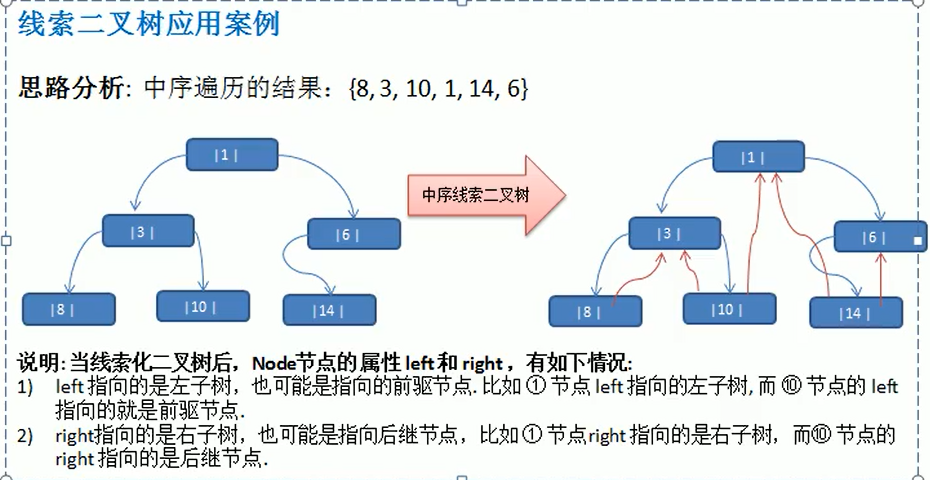线索化二叉树介绍:
1)n个节点的二叉树含有n+1【公式 2n-(n-1)=n+1】个空指针域。利用二叉链表中的空指针域,存放指向该节点在某种遍历次序下的前驱和后继节点的指针(这种附加指针称为“线索”)
2)这种加上了线索的二叉链表称为线索链表,相应的二叉树称为线索二叉树。根据线索性质的不同,线索二叉树可以分为前序线索二叉树,中序线索二叉树和后序线索二叉树三种。
3)一个节点的前一个节点,称为前驱节点
4)一个节点的后一个节点,称为后继节点


对线索化二叉树进行遍历
代码实现:
public class ThreadedBinaryTreeDemo { public static void main(String[] args) { //测试一把中序线索二叉树的功能 HeroNode root = new HeroNode(1, "tom"); HeroNode node2 = new HeroNode(3, "jack"); HeroNode node3 = new HeroNode(6, "smith"); HeroNode node4 = new HeroNode(8, "mary"); HeroNode node5 = new HeroNode(10, "king"); HeroNode node6 = new HeroNode(14, "dim"); //二叉树,后面我们要递归创建, 现在简单处理使用手动创建 root.setLeft(node2); root.setRight(node3); node2.setLeft(node4); node2.setRight(node5); node3.setLeft(node6); //测试中序线索化 ThreadedBinaryTree threadedBinaryTree = new ThreadedBinaryTree(); threadedBinaryTree.setRoot(root); threadedBinaryTree.threadedNodes(); //测试: 以10号节点测试 HeroNode leftNode = node5.getLeft(); HeroNode rightNode = node5.getRight(); System.out.println("10号结点的前驱结点是 =" + leftNode); //3 System.out.println("10号结点的后继结点是=" + rightNode); //1 //当线索化二叉树后,能在使用原来的遍历方法 //threadedBinaryTree.infixOrder(); System.out.println("使用线索化的方式遍历 线索化二叉树"); threadedBinaryTree.threadedList(); // 8, 3, 10, 1, 14, 6 } } //定义ThreadedBinaryTree 实现了线索化功能的二叉树 class ThreadedBinaryTree { private HeroNode root; //为了实现线索化,需要创建要给指向当前结点的前驱结点的指针 //在递归进行线索化时,pre 总是保留前一个结点 private HeroNode pre = null; public void setRoot(HeroNode root) { this.root = root; } //重载一把threadedNodes方法 public void threadedNodes() { this.threadedNodes(root); } //遍历线索化二叉树的方法 public void threadedList() { //定义一个变量,存储当前遍历的结点,从root开始 HeroNode node = root; while(node != null) { //循环的找到leftType == 1的结点,第一个找到就是8结点 //后面随着遍历而变化,因为当leftType==1时,说明该结点是按照线索化 //处理后的有效结点 while(node.getLeftType() == 0) { node = node.getLeft(); } //打印当前这个结点 System.out.println(node); //如果当前结点的右指针指向的是后继结点,就一直输出 while(node.getRightType() == 1) { //获取到当前结点的后继结点 node = node.getRight(); System.out.println(node); } //替换这个遍历的结点 node = node.getRight(); } } //编写对二叉树进行中序线索化的方法 /** * * @param node 就是当前需要线索化的结点 */ public void threadedNodes(HeroNode node) { //如果node==null, 不能线索化 if(node == null) { return; } //(一)先线索化左子树 threadedNodes(node.getLeft()); //(二)线索化当前结点[有难度] //处理当前结点的前驱结点 //以8结点来理解 //8结点的.left = null , 8结点的.leftType = 1 if(node.getLeft() == null) { //让当前结点的左指针指向前驱结点 node.setLeft(pre); //修改当前结点的左指针的类型,指向前驱结点 node.setLeftType(1); } //处理后继结点 if (pre != null && pre.getRight() == null) { //让前驱结点的右指针指向当前结点 pre.setRight(node); //修改前驱结点的右指针类型 pre.setRightType(1); } //!!! 每处理一个结点后,让当前结点是下一个结点的前驱结点 pre = node; //(三)在线索化右子树 threadedNodes(node.getRight()); } //删除结点 public void delNode(int no) { if(root != null) { //如果只有一个root结点, 这里立即判断root是不是就是要删除结点 if(root.getNo() == no) { root = null; } else { //递归删除 root.delNode(no); } }else{ System.out.println("空树,不能删除~"); } } //前序遍历 public void preOrder() { if(this.root != null) { this.root.preOrder(); }else { System.out.println("二叉树为空,无法遍历"); } } //中序遍历 public void infixOrder() { if(this.root != null) { this.root.infixOrder(); }else { System.out.println("二叉树为空,无法遍历"); } } //后序遍历 public void postOrder() { if(this.root != null) { this.root.postOrder(); }else { System.out.println("二叉树为空,无法遍历"); } } //前序遍历 public HeroNode preOrderSearch(int no) { if(root != null) { return root.preOrderSearch(no); } else { return null; } } //中序遍历 public HeroNode infixOrderSearch(int no) { if(root != null) { return root.infixOrderSearch(no); }else { return null; } } //后序遍历 public HeroNode postOrderSearch(int no) { if(root != null) { return this.root.postOrderSearch(no); }else { return null; } } } //先创建HeroNode 结点 class HeroNode { private int no; private String name; private HeroNode left; //默认null private HeroNode right; //默认null //说明 //1. 如果leftType == 0 表示指向的是左子树, 如果 1 则表示指向前驱结点 //2. 如果rightType == 0 表示指向是右子树, 如果 1表示指向后继结点 private int leftType; private int rightType; public int getLeftType() { return leftType; } public void setLeftType(int leftType) { this.leftType = leftType; } public int getRightType() { return rightType; } public void setRightType(int rightType) { this.rightType = rightType; } public HeroNode(int no, String name) { this.no = no; this.name = name; } public int getNo() { return no; } public void setNo(int no) { this.no = no; } public String getName() { return name; } public void setName(String name) { this.name = name; } public HeroNode getLeft() { return left; } public void setLeft(HeroNode left) { this.left = left; } public HeroNode getRight() { return right; } public void setRight(HeroNode right) { this.right = right; } @Override public String toString() { return "HeroNode [no=" + no + ", name=" + name + "]"; } //递归删除结点 //1.如果删除的节点是叶子节点,则删除该节点 //2.如果删除的节点是非叶子节点,则删除该子树 public void delNode(int no) { //思路 /* * 1. 因为我们的二叉树是单向的,所以我们是判断当前结点的子结点是否需要删除结点,而不能去判断当前这个结点是不是需要删除结点. 2. 如果当前结点的左子结点不为空,并且左子结点 就是要删除结点,就将this.left = null; 并且就返回(结束递归删除) 3. 如果当前结点的右子结点不为空,并且右子结点 就是要删除结点,就将this.right= null ;并且就返回(结束递归删除) 4. 如果第2和第3步没有删除结点,那么我们就需要向左子树进行递归删除 5. 如果第4步也没有删除结点,则应当向右子树进行递归删除. */ //2. 如果当前结点的左子结点不为空,并且左子结点 就是要删除结点,就将this.left = null; 并且就返回(结束递归删除) if(this.left != null && this.left.no == no) { this.left = null; return; } //3.如果当前结点的右子结点不为空,并且右子结点 就是要删除结点,就将this.right= null ;并且就返回(结束递归删除) if(this.right != null && this.right.no == no) { this.right = null; return; } //4.我们就需要向左子树进行递归删除 if(this.left != null) { this.left.delNode(no); } //5.则应当向右子树进行递归删除 if(this.right != null) { this.right.delNode(no); } } //编写前序遍历的方法 public void preOrder() { System.out.println(this); //先输出父结点 //递归向左子树前序遍历 if(this.left != null) { this.left.preOrder(); } //递归向右子树前序遍历 if(this.right != null) { this.right.preOrder(); } } //中序遍历 public void infixOrder() { //递归向左子树中序遍历 if(this.left != null) { this.left.infixOrder(); } //输出父结点 System.out.println(this); //递归向右子树中序遍历 if(this.right != null) { this.right.infixOrder(); } } //后序遍历 public void postOrder() { if(this.left != null) { this.left.postOrder(); } if(this.right != null) { this.right.postOrder(); } System.out.println(this); } //前序遍历查找 /** * * @param no 查找no * @return 如果找到就返回该Node ,如果没有找到返回 null */ public HeroNode preOrderSearch(int no) { System.out.println("进入前序遍历"); //比较当前结点是不是 if(this.no == no) { return this; } //1.则判断当前结点的左子节点是否为空,如果不为空,则递归前序查找 //2.如果左递归前序查找,找到结点,则返回 HeroNode resNode = null; if(this.left != null) { resNode = this.left.preOrderSearch(no); } if(resNode != null) {//说明我们左子树找到 return resNode; } //1.左递归前序查找,找到结点,则返回,否继续判断, //2.当前的结点的右子节点是否为空,如果不空,则继续向右递归前序查找 if(this.right != null) { resNode = this.right.preOrderSearch(no); } return resNode; } //中序遍历查找 public HeroNode infixOrderSearch(int no) { //判断当前结点的左子节点是否为空,如果不为空,则递归中序查找 HeroNode resNode = null; if(this.left != null) { resNode = this.left.infixOrderSearch(no); } if(resNode != null) { return resNode; } System.out.println("进入中序查找"); //如果找到,则返回,如果没有找到,就和当前结点比较,如果是则返回当前结点 if(this.no == no) { return this; } //否则继续进行右递归的中序查找 if(this.right != null) { resNode = this.right.infixOrderSearch(no); } return resNode; } //后序遍历查找 public HeroNode postOrderSearch(int no) { //判断当前结点的左子节点是否为空,如果不为空,则递归后序查找 HeroNode resNode = null; if(this.left != null) { resNode = this.left.postOrderSearch(no); } if(resNode != null) {//说明在左子树找到 return resNode; } //如果左子树没有找到,则向右子树递归进行后序遍历查找 if(this.right != null) { resNode = this.right.postOrderSearch(no); } if(resNode != null) { return resNode; } System.out.println("进入后序查找"); //如果左右子树都没有找到,就比较当前结点是不是 if(this.no == no) { return this; } return resNode; } }